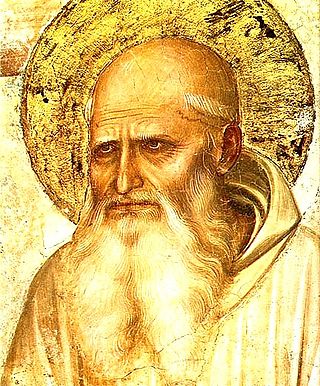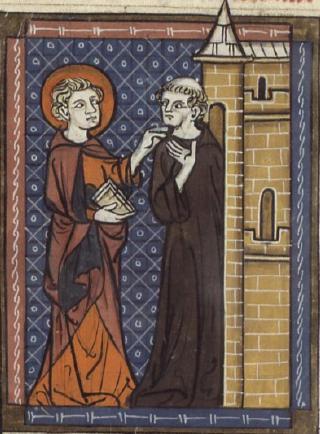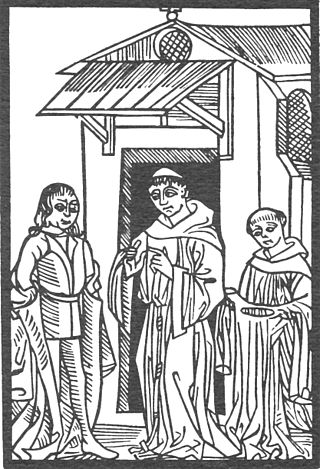Related Research Articles

Anthony the Great was a Christian monk from Egypt, revered since his death as a saint. He is distinguished from other saints named Anthony, such as Anthony of Padua, by various epithets: Anthony of Egypt, Anthony the Abbot, Anthony of the Desert, Anthony the Anchorite, Anthony the Hermit, and Anthony of Thebes. For his importance among the Desert Fathers and to all later Christian monasticism, he is also known as the Father of All Monks. His feast day is celebrated on 17 January among the Eastern Orthodox and Catholic churches and on Tobi 22 in the Coptic calendar.

Christian demonology is the study of demons from a Christian point of view. It is primarily based on the Bible, the interpretation of these scriptures, the writings of early Christianity philosophers, hermits and the associated traditions and legends incorporated from other beliefs.

Romuald was the founder of the Camaldolese order and a major figure in the eleventh-century "Renaissance of eremitical asceticism". Romuald spent about 30 years traversing Italy, founding and reforming monasteries and hermitages.

Demon: The Fallen is a 2002 tabletop role-playing game released by White Wolf Publishing. Set in the World of Darkness, players take on the role of a demon - a fallen angel who descended to the Garden of Eden with Lucifer, only to be condemned to Hell after a long war with Heaven. The game focuses on "infernal glory" as its central theme for storytelling and character development - the acquisition of power to restore the Fallen's grace as well as to potentially reconnect with humanity, all the while staving off their own agony and evading monstrous demons.

The Apocalypse of Peter is an early Christian text of the 2nd century and an example of apocalyptic literature with Hellenistic overtones. It is not included in the standard canon of the New Testament, but is mentioned in the Muratorian fragment, the oldest surviving list of New Testament books, which also states that some authorities would not have it read in church. The text is extant in two incomplete versions of a lost Greek original, a later Greek version and an Ethiopic version, which diverge considerably. The work is classed as part of New Testament apocrypha.
Onuphrius lived as a hermit in the desert of Upper Egypt in the 4th or 5th centuries. He is venerated as Saint Onuphrius in both the Roman Catholic and Eastern Catholic churches, as Venerable Onuphrius in Eastern Orthodoxy, and as Saint Nofer the Anchorite in Oriental Orthodoxy.

Mephisto is a fictional character appearing in American comic books published by Marvel Comics. The character first appeared in Silver Surfer #3, and was created by Stan Lee and John Buscema and based on Mephistopheles – a demon character from the Faust legend, who has sometimes been referred to as Mephisto. Introduced as a recurring adversary of the Silver Surfer and Johnny Blaze, the second incarnation of the Ghost Rider, Mephisto has also endured as one of Spider-Man's most prominent adversaries, being responsible for Norman and Harry Osborn's respective transformations into the Green Goblin and Kindred; and for the superhero's loss of his marriage to Mary-Jane Watson, considering their future daughter Spider-Girl his archenemy. Mephisto has often come into conflict with Doctor Strange, Doctor Doom, Scarlet Witch and other heroes of the Marvel Universe, being responsible both for the creation of the Cosmic Ghost Rider and the descents of Phil Coulson and Otto Octavius into villainy.

March 24 - Eastern Orthodox liturgical calendar - March 26

The Apocalypse of Paul is a fourth-century non-canonical apocalypse and part of the New Testament apocrypha. The full original Greek version of the Apocalypse is lost, although fragmentary versions still exist. Using later versions and translations, the text has been reconstructed, notably from Latin and Syriac translations. The text is not to be confused with the gnostic Coptic Apocalypse of Paul, which is unlikely to be related.

St Patrick's Purgatory is an ancient pilgrimage site on Station Island in Lough Derg, County Donegal, Ireland. According to legend, the site dates from the fifth century, when Christ showed Saint Patrick a cave, sometimes referred to as a pit or a well, on Station Island that was an entrance to Purgatory. Its importance in medieval times is clear from the fact that it is mentioned in texts from as early as 1185 and shown on maps from all over Europe as early as the fifteenth century. It is the only Irish site designated on Martin Behaim's world map of 1492.

In religion and folklore, hell is a location or state in the afterlife in which evil souls are subjected to punitive suffering, most often through torture, as eternal punishment after death. Religions with a linear divine history often depict hells as eternal destinations, the biggest examples of which are Christianity and Islam, whereas religions with reincarnation usually depict a hell as an intermediary period between incarnations, as is the case in the dharmic religions. Religions typically locate hell in another dimension or under Earth's surface. Other afterlife destinations include heaven, paradise, purgatory, limbo, and the underworld.

Particular judgment, according to Christian eschatology, is the divine judgment that a departed person undergoes immediately after death, in contradistinction to the general judgment of all people at the end of the world.

In Christian theology, Hell is the place or state into which, by God's definitive judgment, unrepentant sinners pass in the general judgment, or, as some Christians believe, immediately after death. Its character is inferred from teaching in the biblical texts, some of which, interpreted literally, have given rise to the popular idea of Hell. Theologians today generally see Hell as the logical consequence of rejecting union with God and with God's justice and mercy.

Saint Fursey was an Irish monk who did much to establish Christianity throughout the British Isles and particularly in East Anglia. He reportedly experienced angelic visions of the afterlife. Fursey is one of the Four Comely Saints.
Haito {c.762-March 17, 836) was the abbot of Reichenau Abbey and Bishop of Basel.

The Visio Tnugdali is a 12th-century religious text reporting the otherworldly vision of the Irish knight Tnugdalus. It was "one of the most popular and elaborate texts in the medieval genre of visionary infernal literature" and had been translated from the original Latin forty-three times into fifteen languages by the 15th century, including Icelandic and Belarusian. The work remained most popular in Germany, with ten different translations into German, and four into Dutch. With a recent resurgence of scholarly interest in Purgatory following works by Jacques Le Goff, Stephen Greenblatt and others, the vision has attracted increased academic attention.

Tractatus de Purgatorio Sancti Patricii is a Latin text written about 1180–1184 by a monk who identified himself as H. of Saltrey. The author is traditionally known as Henry, though this was an insertion and invention of Matthew of Paris and has been contested in the influential work of historian Jacques le Goff. H de Saltrey was a Cistercian in Huntingdonshire.
Dryhthelm, also known as Drithelm or Drythelm, was a monk associated with the monastery of Melrose known from the Historia Ecclesiastica gentis Anglorum of Bede. According to the latter, before entering the religious life he lived with his family in "a district of Northumbria which is called Incuneningum". Incuneningum is thought by some modern scholars to refer to Cunninghame, now part of Ayrshire.
Peter Damian, OSB was a reforming Benedictine monk and cardinal in the circle of Pope Leo IX. Dante placed him in one of the highest circles of Paradiso as a great predecessor of Francis of Assisi and he was declared a Doctor of the Church on 27 September 1828. His feast day is 21 February.
The Vision of Adamnán or Adamnán's Vision, also spelled Adomnán, in Irish Fís Adamnáin, is a work of visionary literature written in Middle Irish in two parts, the first dating to the 11th century and the second the early 10th. It has sometimes been dated as early as the 8th or 9th century. Its authorship is unknown. The third-person narrative describes a vision of heaven and hell attributed to Adamnán, abbot of Hy and Iona and primary biographer of Saint Columba.
References
- 1 2 3 4 5 Katherine I. Rabenstein (1998). "Saint of the Day, March 25: Barontius (Barontus) & Desiderius". SaintPatrickDC.org. Archived from the original on February 22, 2012. Retrieved March 7, 2012.
- ↑ Eileen Gardiner (2006). "Judeo-Christian Hell Texts". Hell-On-Line. Retrieved May 18, 2009.
- 1 2 3 4 Caroline Walker Bynum, Paul H. Freedman, Last things: death and the Apocalypse in the Middle Ages (University of Pennsylvania Press, 2000), 54.
- 1 2 3 4 5 6 Eileen Gardiner, Medieval visions of heaven and hell: a sourcebook (Published by Taylor & Francis, 1993), 43-44.
- 1 2 3 "Den hellige Barontius og Desiderius av Pistoia (d. ~725)". Katolsk. 1998-11-07. Archived from the original on March 16, 2005. Retrieved May 14, 2009.